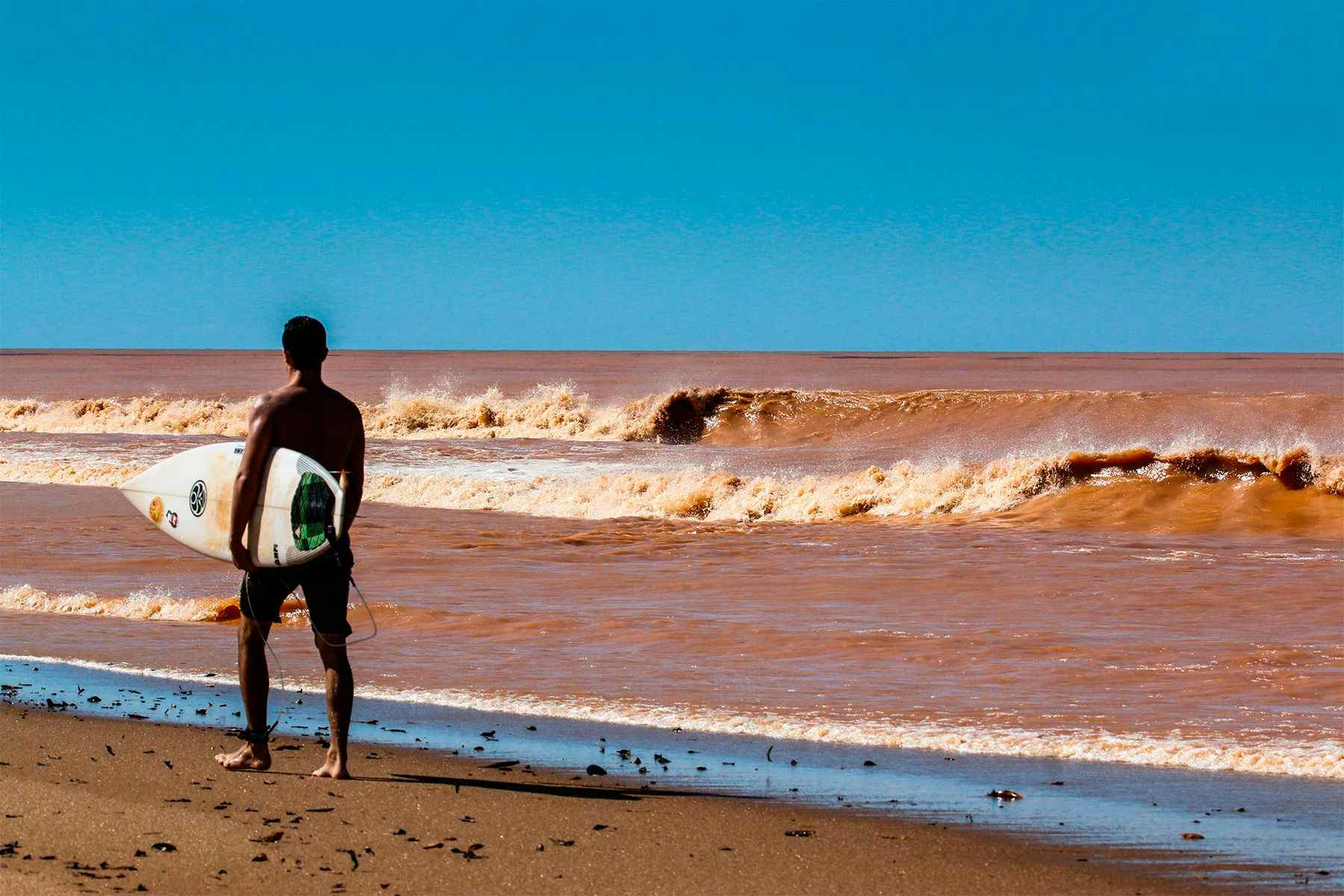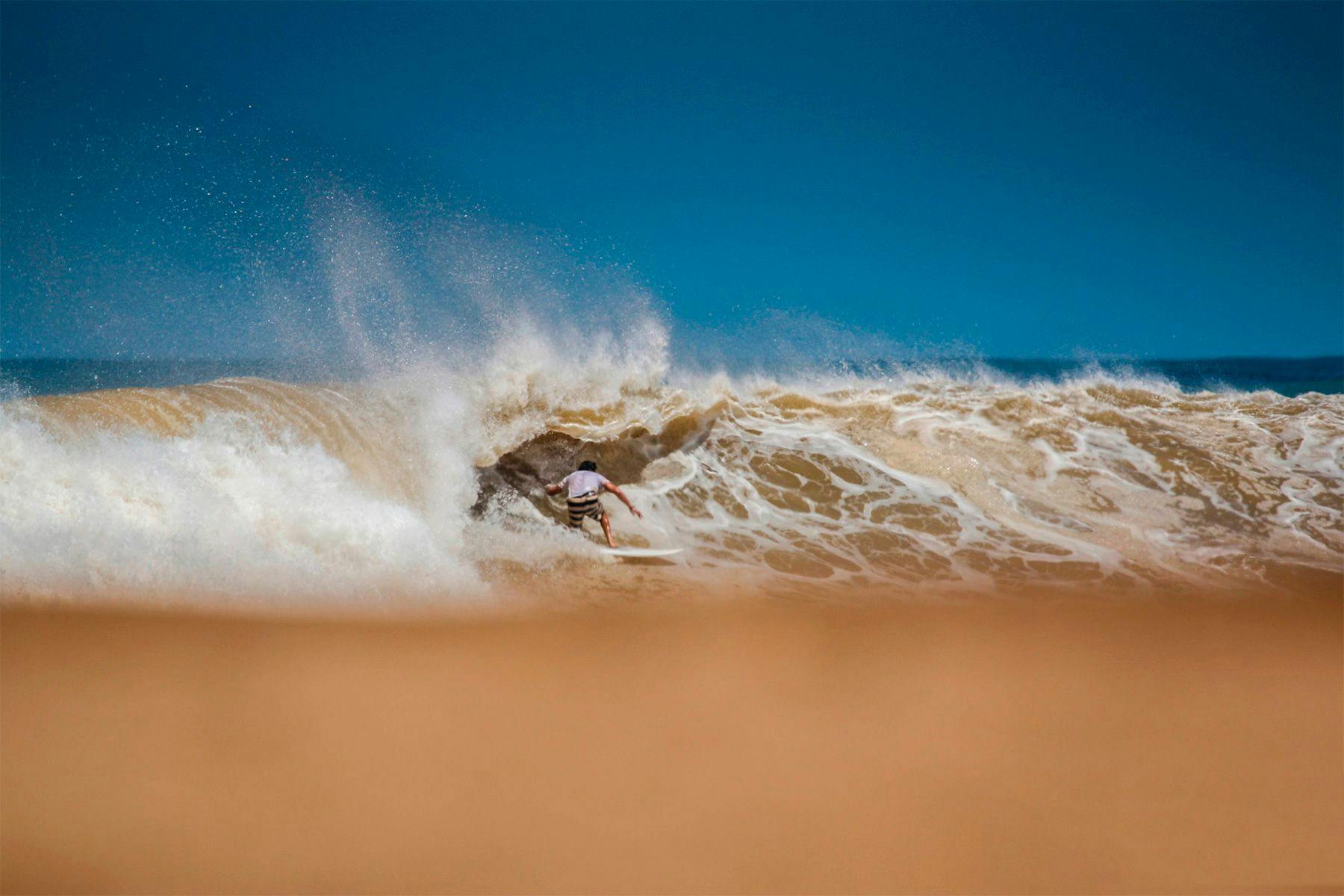NatureThe Disaster of Rio Doce: The Bitter Story Of A Sweet River

The words “surfing” and “mining” are not often found in the same sentence, but when they are, one struggles to think of a way in which it could be positive. Unfortunately, surfers from the village of Regencia, in the state of Espirito Santo, Brazil, have become used to such word associations – albeit against their will – after the waters of one of Brazil’s top surf destinations (often referred to as “Bali’s cousin”) turned from turquoise blue to a muddy radioactive soup following the rupture of the Fundão dam located more than 600km inland. The reason for such an abrupt metamorphosis? Mining.
When Mining Meets Surfing
Simply put, mining is the extraction of valuable minerals or other materials from the earth. Among these materials, metals are the most well-known. Iron is the world’s most commonly used metal, and steel – of which iron ore is the key ingredient – represents almost 95% of all metal used per year. Brazil is the second biggest producer of iron ore in the world, after Australia. The state of Minas Gerais – which is located in the center of the country, north of Rio de Janeiro – has the highest concentration of industrial mines in Brazil. In 2015 the state was the source of more than half (288 million tons) of all the iron produced by the country (418 million tons).
Among the enterprises that commercially mine iron in Brazil, Vale S.A. is the biggest mining company in the country and the third-largest in the world. In 2015, the company was responsible for 73,7% of the extraction of iron in the country, most of which came from the states of Minas Gerais and Pará. In 1977, Vale S.A. joined forces with English-Australian giant BHP Billiton, to form the Samarco S.A. In 2015, an event involving the collapse of a dam that was owned by Samarco, released a mix of contaminated water and mud that flowed into nearby rivers, spreading all the way to the Atlantic Ocean. This is considered as the worst environmental disaster in Brazil’s history, and one of the worst in the world.

A Fine Line Between “Accident” and “Environmental Crime”
The dams of Fundão and Santarém are part of the Germano Mine, located in the municipality of Mariana, Minas Gerais. These structures were built by the Samarco S.A. to accommodate mining waste that came from the iron ore mines of the region. The Fundão dam was going through a process of renovation to elevate its walls – since it had reached the limits of mineral waste that it could hold – when at approximately 3:30 pm on the 5th of November 2015, the structure started to leak. A team of experts was sent to the scene, where they tried to control the leakage by reducing the level of the reservoir. But, at about 4:20 pm, the dam cracked and released a huge amount of toxic sludge into the Santarém river valley, going over the Santarém dam and almost entirely flooding the town of Bento Rodrigues with mud. More than 600 people were evacuated to the nearby town of Mariana, but the fact that neither the mining enterprise nor the local communities had an evacuation plan made the entire event a lot more catastrophic. At least 17 people died and more than 50 were injured.
By the evening of the same day, the toxic mud and water reached the Rio Doce (translated as “sweet river”) – a river that runs for 853km (530 mi) along the south-east of Brazil and supplies more than 230 municipalities across the states of Minas Gerais and Espirito Santo. This river is very important to the ecology of the area, as well as for sustaining the local economic activities of agriculture (dairy and beef cattle, coffee, sugar cane, and cocoa), industry (textile, paper, food, mechanical, etc), and mining (iron, gold, and precious stones). Many cities and villages that once depended on the river were forced to stop taking water from it due to the amount of mud. On the 10th of November, analyses carried out in the city showed great concentrations of elements such as arsenic and mercury in the water, and a State of Public Calamity was declared in response to the water shortage in the region. Moreover, the IBAMA – an institute responsible for many activities focused on the preservation, supervision, and conservation of the natural environment in Brazil – found that, of the 80 species present in the Rio Doce 11 had become endangered and a further 12 (that were endemic to this region) were possibly extinct. This consequence presents a huge problem for local communities since many of them depend on fishing as a means of subsistence and scientists say that the toxic waste will take decades to dilute to acceptable levels.
??
When The River Meets The Sea
On the 22nd of November, the toxic mudflow finally reached the Atlantic Ocean. It spread along the coastline of Espirito Santo in either direction and the district of Linhares had some of its beaches closed down, with an alert for people to stay out of the water. Within two days the mud had spread for more than 15km north of the mouth of the Rio Doce, and over 7km to the south. One of the most affected regions was the Biological Reserve of Comboios, which is a conservation center that protects the only location in Brazil where the leatherback sea turtle lays its eggs. Once at the ocean, the mud began to affect many species of marine fauna and flora and consequently threaten the lives of organisms that may use the estuary as a home during any given part of their cycle of life. This impact occurred in different ways: not only was the water polluted with chemical compounds and heavy metals carried by the sludge, but the amount of mud in the river reduced the levels of oxygen in the water, which altered the course of currents, the fertility of the soil, and ultimately blocked the gills of fish, killing them by suffocation.
After the disaster, many specialists suggested that this hadn’t in fact been an accident, but the result of a lack of monitoring of the dam, as it became known that the amount of waste being held in the reservoir was more than the dam was built to hold. The IBAMA enforced a fine of R$ 250 million (US$ 80million) to Samarco to cover the costs of trying to repair the damage done to the ecology and local communities. During the first days after the tragedy, many social movements and NGOs mobilised in the area to help; be it by medical assistance or in the fight for the rights of local residents. At the same time, research groups from public universities started to carry out analyses and studies to find out more about the effects of the tragedy on the environment and the people. After signing a contract with the federal government and the government of Minas Gerais and Espirito Santo, the Samarco S.A. created the Fundação Renova – an institution responsible for conducting programmes to assist in repairing and restoring the infrastructure, economy, and ecology of the areas affected by the disaster.

The Slick In The Surf
Regencia is widely known among the Brazilian surf community for its incredibly cylindrical barrels and peaceful atmosphere. The village’s 1,200 inhabitants rely mainly on fishing and tourism as a source of income and the “disaster” (with a sour aftertaste taste of corporate environmental crime) has flipped the place upside down, disrupting not only its means of income generation but also the health of its inhabitants. Since then, locals – including the local surf forecast website, Regencia Surf – have been fighting for recognition and for their rights, as well as for compensation for the damages with hopes to bring those responsible for the “accident” – which caused the death of dozens of people and displacement of thousands along the region affected – to justice.
In December 2017, surfers of Regencia applied to be formally recognized as a subculture affected by the environmental disaster. In their petition, surfers point out that the sport – alongside conservation activities of sea turtles – is the main driver of tourism in the region, since Regencia’s peaks attract visitors from various parts of Brazil. However, for more than two years, the surfing here has suffered a major setback due to the contamination of the water which scares many people from paddling out. Hence surfers, local associations and hotels, as well as the State Surf Federation, have already carried out various acts of protest against the social and environmental impacts and impunity associated with the crime. Finally, in December, the Public Defender’s Offices of Espírito Santo carried a public civil action against 26 names involved, asking for the application of a fine and the release of an official document enforcing the payment to all of those affected.

Surfing and Politics
As mainstream media outlets speed past news events, we, the spectators, carry on with life while the aftermath of what happened remain embedded in the lives of those affected for days, months, even years to come. Not only did the mudslides and water pollution cause huge ecological problems but they also left a cultural scar, where many species (including humans) are forced to adapt and risk never fully recovering. The disaster of river Doce is a great example of our modern day “food chain”, where the voice of the common people is often still overpowered by that of big corporations. Even though the incident affected mainly small, isolated communities in Brazil, its repercussions reached across the entire nation, ultimately alarming the world. The incident also exposed signs of a political frustration – something long-familiar in Brazil – at corporations that often act with an impunity which has, over the course of many years, become integrated into the social and political culture to the point that is is somehow seen as “acceptable”. As a result, small surfing communities, like the one in Regencia, struggle to access and claim their rights, before they are even able to surf.
The author and Surf Simply would like to Thank Thiago Vieira (@thiagovieirafotografo) and Shot Spot Brasil (@shotspot.com.br) for the use of their photography.